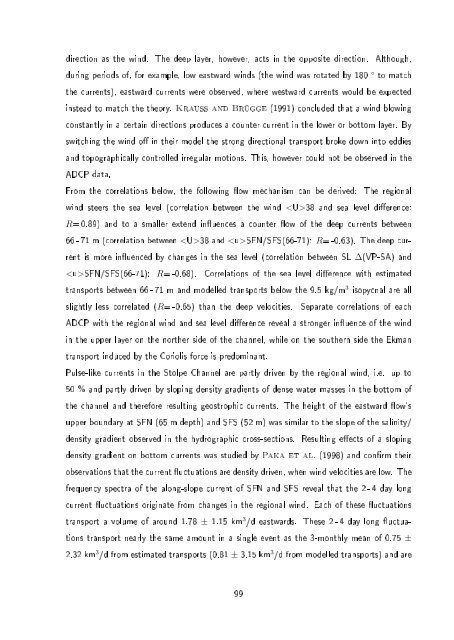Baltic Sea
Baltic Sea
Baltic Sea
You also want an ePaper? Increase the reach of your titles
YUMPU automatically turns print PDFs into web optimized ePapers that Google loves.
direction as the wind. The deep layer, however, acts in the opposite direction. Although,<br />
during periods of, for example, low eastward winds (the wind was rotated by 180 ◦ to match<br />
the currents), eastward currents were observed, where westward currents would be expected<br />
instead to match the theory. Krauss and Brügge (1991) concluded that a wind blowing<br />
constantly in a certain directions produces a counter current in the lower or bottom layer. By<br />
switching the wind o in their model the strong directional transport broke down into eddies<br />
and topographically controlled irregular motions. This, however could not be observed in the<br />
ADCP data.<br />
From the correlations below, the following ow mechanism can be derived: The regional<br />
wind steers the sea level (correlation between the wind 38 and sea level dierence:<br />
R= 0.89) and to a smaller extend inuences a counter ow of the deep currents between<br />
66 - 71 m (correlation between 38 and SFN/SFS(66-71): R= -0.63). The deep current<br />
is more inuenced by changes in the sea level (correlation between SL ∆(VP-SA) and<br />
SFN/SFS(66-71): R= -0.68). Correlations of the sea level dierence with estimated<br />
transports between 66 - 71 m and modelled transports below the 9.5 kg/m 3 isopycnal are all<br />
slightly less correlated (R= -0.65) than the deep velocities. Separate correlations of each<br />
ADCP with the regional wind and sea level dierence reveal a stronger inuence of the wind<br />
in the upper layer on the norther side of the channel, while on the southern side the Ekman<br />
transport induced by the Coriolis force is predominant.<br />
Pulse-like currents in the Stolpe Channel are partly driven by the regional wind, i.e. up to<br />
50 % and partly driven by sloping density gradients of dense water masses in the bottom of<br />
the channel and therefore resulting geostrophic currents. The height of the eastward ow's<br />
upper boundary at SFN (65 m depth) and SFS (52 m) was similar to the slope of the salinity/<br />
density gradient observed in the hydrographic cross-sections. Resulting eects of a sloping<br />
density gradient on bottom currents was studied by Paka et al. (1998) and conrm their<br />
observations that the current uctuations are density driven, when wind velocities are low. The<br />
frequency spectra of the along-slope current of SFN and SFS reveal that the 2 - 4 day long<br />
current uctuations originate from changes in the regional wind. Each of these uctuations<br />
transport a volume of around 1.78 ± 1.15 km 3 /d eastwards. These 2 - 4 day long uctuations<br />
transport nearly the same amount in a single event as the 3-monthly mean of 0.75 ±<br />
2.32 km 3 /d from estimated transports (0.81 ± 3.15 km 3 /d from modelled transports) and are<br />
99



